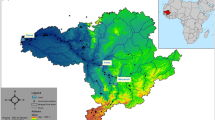Abstract
The mathematical modelling of a river basin water balance is a complex process which requires extensive calibration and the use of data that are frequently not available. The seasonal soil compartment model, SESOIL, of the USEPA, is an international tool well suited for this purpose. Knowledge of the water balance on an annual or a monthly basis is particularly important in regions with increased water demand and limited resources. SESOIL has been applied to the Pinios River Basin in Central Greece. Observed input and simulated output are discussed. The model behaved well. The study extends the use of SESOIL which can be run with limited calibration compared to other models in the literature and with data readily available in Europe such as the Corine land cover. Simulations can be used for water allocation practices, water related impacts due to climatic changes and other human activities indicated in the new EC Water Framework Directive EC/2000/60.
Résumé
La modélisation numérique du bilan hydrologique d’un bassin versant est une opération complexe qui demande d’importantes calibrations et des données qui ne sont pas toujours disponibles. Le modèle SESOIL d’USEPA est un outil international bien adapté. La connaissance des bilans hydrologiques, sur une base mensuelle ou annuelle, est particulièrement importante pour des régions où la demande en eau augmente et où les ressources sont limitées. SESOIL a été utilisé pour le bassin versant de Pinios en Grèce centrale. Les données d’entrée du modèle, mesurées, et les résultats de sortie du modèle, calculés, sont discutés. Le modèle se comporte correctement. L’étude ètend le domaine d’application de SESOIL qui peut être mis enœuvre avec peu de calibrations, comparé aux autres modèles du commerce, et avec des données facilement disponibles en Europe telles que le modèle de terrain Corine. Des simulations peuvent être réalisées pour des projets de distribution d’eau, pour étudier les conséquences hydrologiques de changements climatiques et d’activités anthropiques décrites dans la nouvelle Directive européenne EC/2000/60.







Similar content being viewed by others
References
Bonazountas M, Fiksel J (1982) ENVIRO: environmental mathematical pollutant fate modelling handbook and catalogue. EPA Contract No. 68-01-5146, draft report, Arthur D. Little, Inc., Cambridge
Bonazountas M, Wagner J (1984) SESOIL: a seasonal soil compartment model Arthur D. Little, Inc., Cambridge
Eagleson P (1978) Climate, soil, and vegetation. 1. Introduction to water balance dynamics. Water Resour Res 14(5)705–712
Hetrick DM (1984) Simulation of the hydrologic cycle for watersheds. In: Paper presented at 9th IASTED international conference, energy, power, and environmental systems, San Francisco
Hetrick DM, Travis CC (1988) Model predictions of watershed erosion components. Water Resour Bull 24(2):413–419
Hetrick DM, Holdeman JT, Luxmoore RJ (1982) AGTEHM: documentation of modifications to the terrestrial ecosystem hydrology model (TEHM) for agricultural applications. ORNL/TM-7856, 119 pp
Hetrick DM, Travis CC, Shirley PS, Etnier EL (1986) Model predictions of watershed hydrologic components. Water Resour Bull 22(5):803–810
Hetrick DM, Travis CC, Leonard SK, Kinerson RS (1989) Quantative validation of pollutant transport components of an unsaturated soil zone model (SESOIL). Oak Ridge National Laboratory, Tennessee, p 42
Kincaid CT, Morrey JR, Rogers JE (1984) Geochemical models for solute migration, vol I. Process description and computer code selection, Report EA-3417, Electric Power Research Institute, Palo Alto
Ladwig KJ (1993) Groundwater contamination susceptibility evaluation, SESOIL modelling results. Prepared for Wisconsin Department of Natural Resources, Madison
Melancon S, Pillard J, Stern S (1986) Evaluation of SESOIL, PRZM, and PESTAN in a laboratoty column leaching experiment. Environ Toxicol Chem 5:865–878
Odencrantz JE, Farr JM, Robinson CE (1992) Transport model parameter sensitivity for soil cleanup level determinations using SESOIL and AT123D in the context of the California leaking underground fuel tank field manual. In: Kostecki PT, Calabrese EJ, Bonazountas M (eds) Hydrocarbon in contaminated soils, vol 11. Lewis Publishers, Chelsea, pp 319–342
Travis CC, Holton GA, Etnier EL, Cook C, O’Donnell FR, Hetrick DM, Dixon E (1986) Assessment of inhalation and ingested population exposures from incinerated hazardous wastes. Environ Int 12:533–540
Tucker WA, Huang C, Dickinson RE (1986) Environmental fate and transport. In: Benzene in Florida groundwater. An assessment of the significance to human health. American Petroleum Institute, Washington, DC, pp 79–122
Vighi M, Funari E (1995) Pesticide risk in groundwater. CRC Press, Lewis Publicatioos, ISBN-0-87371-439–3
Walsh PJ, Barnthouse LW, Calle EE, Cooper AC, Copenhaven ED, Dixon ED, Dundey CS, Griffin GD, Hetrick DM, Holton GA, Jones TD, Murphy BD, Suter GW, Travis CC, Uziel M (1984) Health and environmental effects documents on direct coal liquefaction—1983. Prepared for Office of Health and Environmental Research and Office of Energy Research, Department of Energy, ORNL/TM-9287, Oak Ridge National Laboratory, Tennessee, p 130
Watson DS, Brown (1985) Testing and evaluation of the SESOIL model. Anderson-Nichols & Co. Prepared for the USEPA, Athens Research Lab, Athens
Zerva I (1985) Mathematical simulation of water dynamics of Pinios River basin. NTUA, Athens
Acknowledgements
The authors acknowledge the European Commission for providing funding for this work (EC/Eurostat Grant Contract No EC/200.17140.0005). In addition, special appreciation is forwarded to Mr. Jon Chen, SAIC Corporation, USA, for the delivery of the model and his contribution in the code performance.
Author information
Authors and Affiliations
Corresponding author
Rights and permissions
About this article
Cite this article
Bonazountas, M., Panagoulia, D., Passas, N. et al. Water balance estimation via SESOIL: Pinios River Basin, Greece. Bull Eng Geol Environ 64, 111–116 (2005). https://doi.org/10.1007/s10064-004-0264-3
Received:
Accepted:
Published:
Issue Date:
DOI: https://doi.org/10.1007/s10064-004-0264-3




